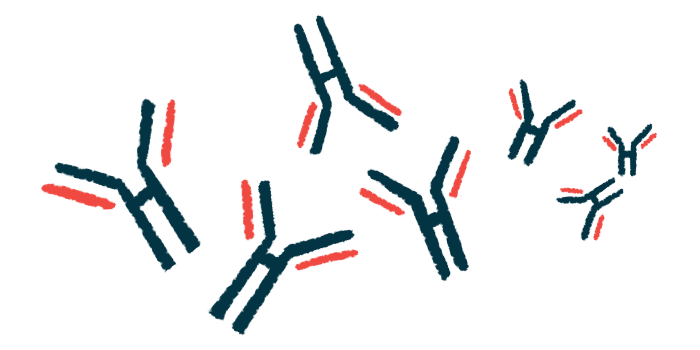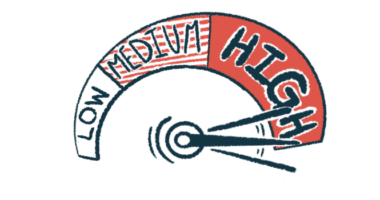Self-reactive antibodies more frequent in NMOSD than MOGAD
Antibodies tied to frequency of general symptoms with adult-onset NMOSD

Self-reactive antibodies linked to other autoimmune diseases are more common in people with neuromyelitis optica spectrum disorder (NMOSD) than in those with myelin oligodendrocyte glycoprotein antibody-associated disease (MOGAD), a related condition.
In fact, the frequency of any other autoimmune disease was nearly six times higher in adults with NMOSD versus MOGAD, according to a review of data from South Asian patients that showed the presence of these self-reactive antibodies, or autoantibodies, was linked to a higher frequency of general symptoms with adult-onset NMOSD.
“By understanding the complexities of autoantibody patterns in … conditions like NMOSD and MOGAD, clinicians can better navigate diagnostic challenges and make more precise clinical decisions,” the researchers wrote.
The study, “Spectrum of Auto-antibodies in NMO and MOG Associated CNS Demyelination-The SANMAD Study,” was published in the Journal of Neuroimmunology.
NMOSD and MOGAD are rare autoimmune diseases marked by an abnormal immune response against healthy cells of the brain and spinal cord. These autoimmune attacks can lead to spinal cord inflammation, called transverse myelitis, and/or inflammation of the nerve that connects the brain and the eyes (optic neuritis).
Most NMOSD cases are associated with self-reactive antibodies that target AQP4, a protein on nerve-supporting cells. MOGAD is linked to autoantibodies against myelin oligodendrocyte glycoprotein (MOG), found on the fatty protective coating surrounding nerve fibers. Both conditions are associated with other autoantibodies commonly found with other autoimmune disorders, including myasthenia gravis, systemic lupus erythematosus (SLE), and Sjögren’s disease. But previous data suggest the coexistence of autoimmune diseases is more frequent in pediatric and adult NMOSD patients with anti-AQP4 autoantibodies than with MOGAD patients.
Comparing autoantibodies in NMOSD, MOGAD
Because of the possible impact on treatment strategies and outcomes, “understanding the connections between autoimmune diseases in patients with [NMOSD and MOGAD] is crucial,” wrote researchers in India who retrospectively analyzed demographic, clinical, and autoantibody data from 102 AQP4-related NMOSD patients and 148 MOGAD patients.
The goal was to compare the frequency of coexisting autoantibodies and autoimmune conditions between NMOSD and MOGAD patients, “representing the first study of its kind in this ethnic group,” the scientists wrote.
The NMOSD group had twice as many females as the MOGAD group (94.1% vs. 48%), was significantly older at disease onset (mean 38.5 vs. 31.1), and had significantly fewer cases of pediatric-onset disease (14.7% vs. 29.1%). Over a median follow-up of 59.5 months, or about five years, significantly more NMOSD patients had a relapse than MOGAD patients (66.7% vs. 50.7%).
Overall, 17.6% of all patients tested positive for at least one autoantibody other than those against AQP4 or MOG, with a two times higher frequency in the NMOSD group relative to the MOGAD group (25.5% vs. 12.2%). Likewise, double autoantibody positivity was significantly more frequent, by four times, in NMOSD cases (5.9% vs. 1.4%).
NMOSD patients had a higher prevalence of antinuclear autoantibodies (3.9% vs. 1.4%), anti-Ro-52 antibodies (12.7% vs. 4.1%), and anti-SS-A antibodies (7.8% vs. 0.7%), which are linked to SLE and Sjögren’s. Sjögren’s was present in three NMOSD patients, but no MOGAD patient.
Still, autoantibody frequencies “did not exceed the typical prevalence found in the general population,” the researchers wrote.
Age of onset and NMOSD, MOGAD
Among adult-onset patients, people with NMOSD were older at disease onset, had a longer disease duration, a greater number of relapses, and more psychiatric symptoms than MOGAD cases. These differences weren’t found among pediatric-onset cases.
Myelitis was more prevalent in pediatric- and adult-onset NMOSD cases than with MOGAD.
Any autoimmune disease occurred nearly six times more often in adult-onset NMOSD versus adult-onset MOGAD cases (5.7% vs. 1%).
Adults in the NMOSD group who tested positive for at least one autoantibody were significantly more likely to have general symptoms, such as fatigue, malaise, depression, low-grade fever, body aches, and exercise intolerance, than those who tested negative (45.5% vs. 23.1%). Conversely, those who were autoantibody-negative had a significantly higher rate of optic neuritis (56.9% vs. 31.8%).
NMOSD was significantly associated with being female, testing positive for at least one autoantibody, along with anti-Ro-52 and anti-SS-A autoantibody positivity, compared with MOGAD, further statistical analyses showed.
“We believe that our current study will provide valuable insights to clinicians, equipping them with essential information for more informed decision-making,” the researchers wrote. “The role of these autoantibodies in disease [mechanisms], clinical [profile], treatment response, and prognosis requires further investigation,” with this knowledge helping to improve patient care and better outcomes.






